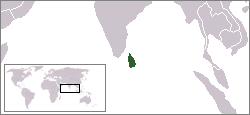Sri Lankan riots of 1958
| 1958 Anti-Tamil pogrom and riots | |
|---|---|

Location of Ceylon
|
|
| Location | Dominion of Ceylon |
| Date | May and June 1958 (+6 GMT) |
| Target | Primarily Tamil and some Sinhalese civilians |
|
Attack type
|
Decapitation, burning, stabbing |
| Weapons | Knives, sticks, fire |
| Deaths | 300-1,500 |
|
Non-fatal injuries
|
1,000+ |
1958 anti-Tamil pogrom and riots in Ceylon, also known as 58 riots, refer to the first island wide ethnic riots and pogrom to target the minority Tamils in the Dominion of Ceylon after it became an independent country from Britain in 1948. The riots lasted from 22 May until 27 May 1958 although sporadic disturbances happened even after the declaration of emergency on 1 June 1958. The estimates of the murders range based on recovered body count from 300 to 1500. Although most of the victims were Tamils, some majority Sinhalese civilians and their property was also affected both by attacking Sinhalese mobs who attacked those Sinhalese who provided sanctuary to Tamils as well as in retaliatory attacks by Tamil mobs in Batticaloa and Jaffna. As the first full-scale race riot in the country in over forty years, the events of 1958 shattered the trust the communities had in one another and led to further polarisation.
In 1956, Solomon Bandaranaike came to power in Ceylon, on a majority Sinhala nationalist platform. The new government passed the Sinhala Only Act, making Sinhala the sole official language of the country. This was done despite the fact that nearly a quarter of the population used Tamil as their primary language. The Act immediately triggered discontent among the Tamils, who perceived their language, culture, and economic position as being subject to an increasing threat.
In protest, Tamil Federal Party politicians launched a satyagraha (Nonviolent resistance) campaign. This led to an environment of increased communal tensions and to the death of over 150 Tamils in the Gal Oya riots in the east of the country. Eventually Bandaranaike entered into negotiations with them and the Federal party and agreed to the Bandaranaike-Chelvanayakam Pact of 1957, which would have made Tamil the administrative language in the Tamil-speaking north and east regions. But he was forced to cancel the pact under pressure from Sinhala nationalists and some Buddhist monks, particularly the United National Party, which organised a 'March on Kandy', led by JR Jayawardene.
...
Wikipedia
